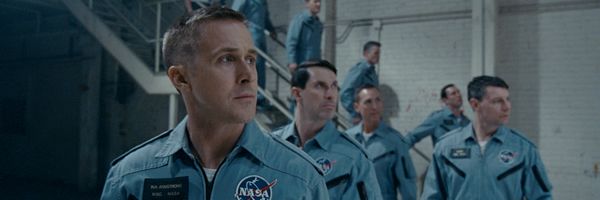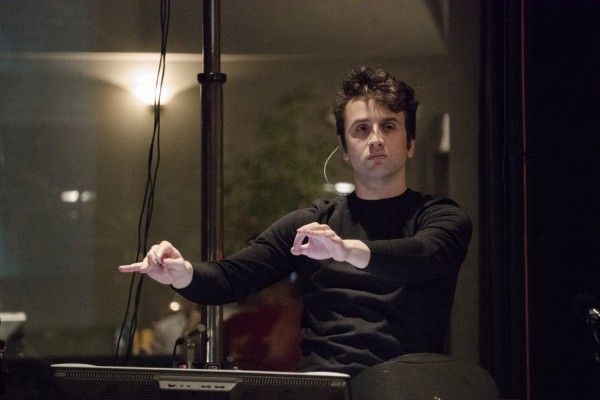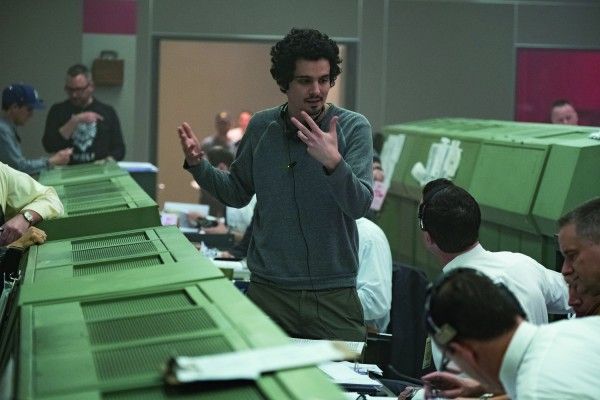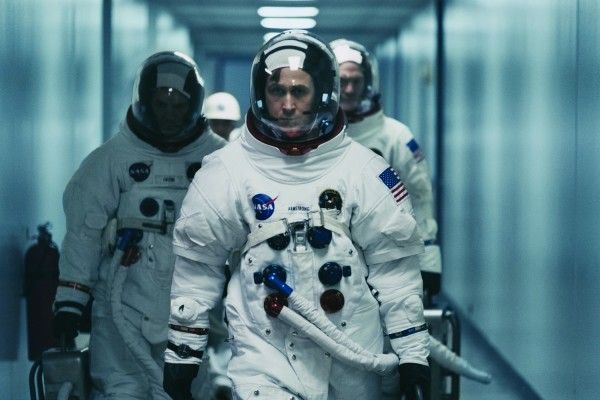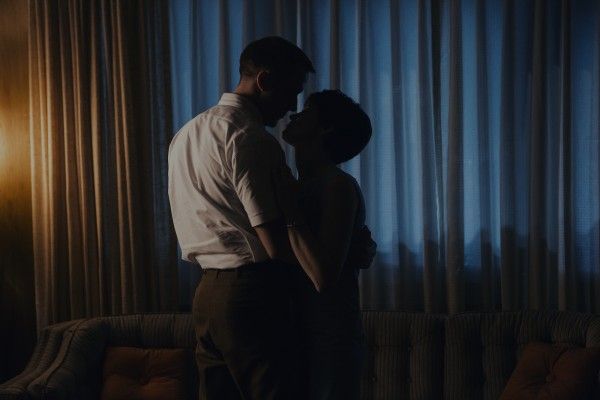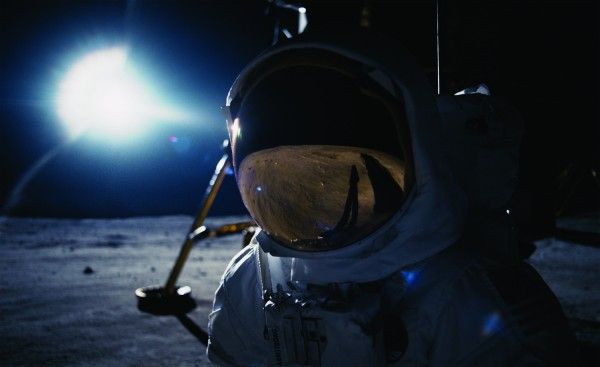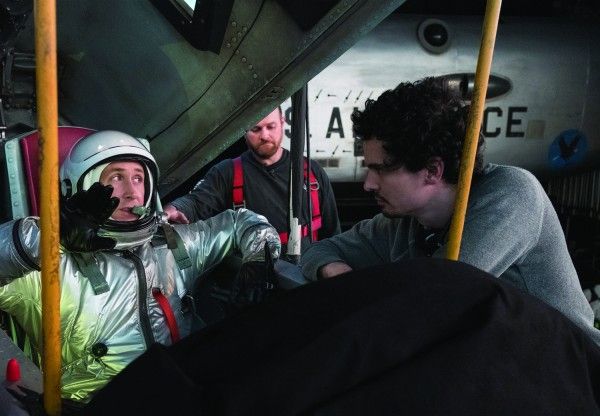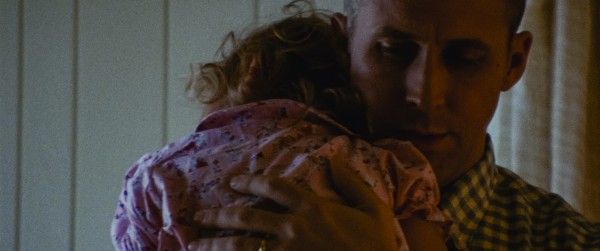How do you combine overwhelming grief and wild ambition to result in a phenomenally melodic film score? Just ask Justin Hurwitz, the composer behind the Neil Armstrong drama First Man. This isn’t Hurwitz’s first collaboration with director Damien Chazelle, as the two were college roommates at Harvard and have been working together ever since. And while Hurwitz earned a pair of Oscars for his score and songwriting on Chazelle’s previous film, La La Land, the composer had his work cut out for him on their next project.
First Man aims to chronicle the story of how man first landed on the moon through the eyes of Neil Armstrong, a deeply quiet and stoic man who carried with him an immense sadness over the death of his daughter Karen shortly before joining the space program. This loss and grief is in many ways the backbone of First Man, conveyed through a tremendously nuanced performance by Ryan Gosling, but the film is also a propulsive story about one of humanity’s greatest achievements. Marrying these two concepts tonally was a challenge that not only Chazelle had to conquer, but Hurwitz as well.
Somehow, someway, Hurwitz captures the sorrow and sadness inside Armstrong with hushed melodies and marries them with the propulsive, almost bombastic themes that accompany the trial-and-error process of putting a man on the moon. As I’ve written previously it’s my favorite score of 2018, so when I was offered the chance to speak with Hurwitz about his First Man score I excitedly seized the opportunity.
During our exclusive interview, Hurwitz went deep on the long, laborious process of finding the film’s themes (the main theme alone took him over 100 tries), his intense collaboration with Chazelle throughout, and how he set about scoring the climactic moon landing sequence. Hurwitz also went into detail about the unique instruments used to bring the First Man score to life, including how the Theremin and harp played key roles albeit in unique ways.
It’s a deep-dive interview about how one of the most memorable scores of the last few years was created. Check it out in full below.
It's a really terrific piece of work, and I know that Damien was working on First Man before even La La Land was made. So I was kind of curious, when did you first hear about the project and what were those initial conversations like?
JUSTIN HURWITZ: I heard about it early on. In fact, I know the reason he first sat down with Ryan Gosling was to pitch him on this Neil Armstrong movie before Ryan knew anything about La La Land, and it was in the course of that conversation that Ryan heard that Damien was also developing a musical and he was interested in that.
So I knew way back then that Damien was developing the script with Josh Singer and he was getting with Ryan to talk about it. Then I didn't think too much about it 'cause we were so busy making La La Land. Sort of the next instance of me being aware of it was Josh would come into the editing room while we were working on La La Land, and he would work with Damien on the script, so I would see Josh coming in. I got to know Josh a little bit and I would hear little bits and pieces about how it was coming along, but, again, I really wasn't thinking about it too much. Damien would give me an early draft to read around that time, kind of half way through editing La La Land. We broke for the holidays. The editing room went down for the holidays, so he gave me the first script just to say, "By the way, this is what we've been working on. If you want to start having it percolate somewhere in the back of your mind."
So I read that early draft but then again didn't think too much about it. Talked a little with Damien about it but didn't think too much about it 'cause we were busy finishing La La Land. Then it wasn't until March of 2017 when Damien started like actually prepping First Man that I really got thinking about it and got working on it. I read another draft of the script that had progressed quite a bit. It was their pre-production draft at that point. So I read another draft and then started working on it with Damien at the time that he was doing his prep for location, costumes, cinematography and all that stuff.
Did he give you any kind of a guiding idea in terms of what he wanted it to sound like or was that kind of left up to you to kind of tool around and kind of work out what you thought would be fitting?
HURWITZ: No, he's very specific in what he's looking for. So the first conversation we had once we really got into it during pre-production, we always start with ... Well, he always wants to know at the beginning what the melodies are gonna be, what the themes are gonna be. Themes are very important to him. It always starts with me sitting at the piano looking to the themes before we get into any instrumentation, any sound ideas. We just talk about themes and he throws words at me, words that kind of get at what he wants to feel from the music.
For this he wanted ... the words he used were loss, pain, grief, loneliness. He wanted to feel all of that in the main theme of the film. So then my job is just to sit down at the piano and look for that, try to find that, and so I feel my way around the piano until I have something that feels right to me. I record at the piano, then when I send it to him and he always says no. Sometimes he'll say why. It's a little too this or it's a little too that, and I'll just keep going. We do this over and over and over again. It was a few hundred attempts at it before I found the right one that was the main theme of this movie. Then as soon as we found that then he wanted to know what's the second theme. There's a second theme in this movie that's kind of like family piece. It's more of a bittersweet kind of rift and he wanted to know what that was next.
So we do that, then after all that's worked out at the piano then we got into what to do with the sounds, what are the sounds of the score? He didn't know what he wanted exactly. He just knew it needed to sound different than anything we had done, so he said, "Why don't you start learning and playing around with some electronic stuff" 'cause we never used any electronics before. So he suggested Theremin, so I got one of those and started playing around with it.
What's that like, by the way? I got like physically giddy when I started hearing the Theremin in the score a little bit.
HURWITZ: Oh, so you knew what one was before?
I saw it at the IMAX press screening at TIFF. I was like, “Is that the Theremin?” and then it just continued on. I was like, "This is amazing."
HURWITZ: Oh, cool, I'm glad you're a fan of the Theremin. So, yeah, that was really fun to start playing around with and experimenting sort of what our melody could sound like on it, and part of the idea was could we use the Theremin in a really emotional way. We're used to hearing a Theremin used in sci-fi movies and sort of B movies from the '50s and '60s. What if we used it in a really expressive melodic way?
So our melody just worked so well. It was so emotional on the Theremin. That was a nice discovery. Then I spent a few months also during pre-production and actually during the shoot while they were off in Atlanta shooting I had a few months back in L.A. just to play around with vintage synths, modular synths. I didn't know anything about any of that stuff. So I watched some YouTube videos on modular synthesizers and then got one and started playing around with it, which was a lot of fun. Started playing around with some production ideas, figuring out some ways to process an orchestra and manipulate an orchestra. So that's where we got the idea of putting all the strings through a Leslie rotor cabinet, which is a speaker cabinet where the speaker spins around inside. So all the strings in the movie were recorded separately one at a time, first violin, second violin, violas and cellos and bases. Then one at a time they were put through the Leslie rotor cabinet, which gives it this kind of swirling whirling quality.
Then after the cabinet they were all put through a tremolo pedal, so that gives it sort of another rate of kind of flutter. Then because every string instrument was done separately you have all these different rates, and I sort of programmed them all with slightly different rates of flutter. So all these tremolo rates were in conflict with each other, and it would create that sort of that sort of interesting shaking fluttering quality in the strings, so that was another idea we came up with.
It's just a way to kind of get at ... Well, first of all, it seemed to sort of fit with the style of the way the movie was shot in kind of a handheld way, like the sort of flutter and shake of the strings, sort of matches that a little bit, and then I also like that the fluttery strings seem to get at the nerves that Neil and people were feeling in the story. I think what was interesting to me is that Neil was so stoic and steely on the outside, but he definitely had quite a bit of nerves inside. I thought that the strings were kind of getting at that.
So that was a fun idea that we came up with. Then we just made some sounds of our own. I got a bunch of scrap metal delivered to my apartment, and I was recording sounds. I was shaking sheet metal to make these thunder sounds, which I would mix in very quietly into the cues to add a sort of like very subtle cosmic nature to them. I was making some ambiences out of pipes, and I was recording fire and water and air inside pipes and pitching it and making some sounds that I would then map over a keyboard and play in as a kind of ambient pad into a lot of the cues, which again, it had a sort of elemental and textural quality that I thought fit with the themes and the sort of cosmic nature of a lot of the story and the themes of the story.
It was just a lot of playing around. We started as early as we did so we would have a lot of time to play around and kind of build a toolbox of sounds and instruments and ideas, so that when we got to post, when he got back from Atlanta we had scenes and we could just sort of hit the ground running and score the scenes. We had a lot of the building blocks worked out by then.
Something I do find interesting about the score and something I really love about it is that it is very melodic. I mean, the world of film music is changing pretty rapidly these days. Obviously it contains multitudes but a lot of scores are blurring the line between score and sound design. People are kind of going anti-melodic and doing that. Is that something you're conscious of as you're kind of working? Because your scores are known for being more melodic, which I love.
HURWITZ: Oh thanks. I mean that's a shared sensibility Damien and I have. We love themes. We love themes that are hummable, that you remember, that can stick with you. There are definitely kind of movies where it's not appropriate and we may make a movie one day where the right thing to do is just a really minimalist or ambient score, but so far the movies we've done he's wanted and I definitely supported the decision as well to have the really lyrical main theme. This movie it just seemed to be right because it's a very emotional movie and the emotion needs to ... Well, Neil is a very reserved and stoic character but he's dealt with the most unimaginable heartbreak of losing a child and then they lose more people who are close to them over the course of the story. There's just so much pain that he and Janet and the family have gone through. We needed to be able to get at that and we needed to be able to let his inner emotional life come out. We kept it sort of tamped down for most of the movie. We kept the theme either in a very sort of deconstructed form where it's just hinted at with a few notes here and there or we kept it very subtly orchestrated, very subtly on a harp or some other light things throughout the movie.
But we knew that as the story progressed and particularly as the Apollo 11 mission started and he got to the moon, like we needed the score to really start blossoming. We needed the emotion to really start blossoming and that's where the weight of the orchestra starts coming in as we leave for the mission and that's where the Theremin really starts coming to the forefront. The Theremin has been in almost every cue to that point but really kind of mixed down into the orchestra and playing more counter melody than anything else and toward the end of the movie the Theremin comes to the front. We wanted it to really start singing and that's where the melody also starts becoming really fully articulated and fully expessed. We allow the melody to really unfold in its full form.
That was because we wanted after all these years of just kind of bottling away the emotion, we wanted Neil to kind of almost break open and all of that to come out. The melody seemed like the best way to really get at his inner workings and inner heartbreak.
I mean tackling the moon landing scene, which was one of the most iconic historical achievements ever. How did you go about crafting music for that as a composer? There were so many different ways you could go. What was kind of your process of tackling that?
HURWITZ: Well, Damien wanted that piece of music created before he shot the movie. So we've been doing this for a while because like certainly when you make a musical you have to make a lot of music before a movie is shot. For instance, song and dance numbers you have to make mock ups so that you can have them on set. People can dance and lipsync and all that. So we've been doing it and Damien really wanted to approach this landing sequence the same way, where once we had the themes worked out, once we had the instrumentation ideas worked out, he said, "Let's make some really important cues, let's make some of the cues that I want to sort of structure these sequences around."
So the landing was the very first one he wanted to tackle. So it started with basically the concept for it. We had the main melody which is kind of the loss and grief melody, the Karen melody and we had that family rift, the triplets rift. He said, "Let's put them together. I want the landing to be the first time that those two pieces of material come together." So how can you sort of overlay them and how can you orchestrate them so that it's something that's carrying that rift while the rest of the cue grows and grows and grows and then explodes in that big, big melody when we cut out of the craft? So he kind of pitched me the concept for it, and then I just started building it one instrument at a time. What's so incredible about Damien is he sees the entire movie in his head before he's shot it. Like, really he sees every shot. He knows the length of the shots. So he'll give me timings and so like with the landing he would give me timings, say, "This section I need it to grow for 40 seconds, and then I want the strings to enter and then I want that to grow for 15 seconds, and then I want the drums to sort of leap off."
He would tell me exactly where the camera would be and what the music would need to be doing. Obviously things change once you get into the editing room and you start cutting the picture, but he gets awfully close before he's even shot the movie. I'm just trying to listen to him, structure it and try to follow the movie that he's seeing in his head. We build the mock-up and then he uses the mock-ups for sequences like this where he wants the early demos. He then uses the demos of the music to storyboard to. So he creates storyboards and then he cuts animatics together to the music so that he can create these sort of pre-visualizations with hand drawn frames and the music and he can cut it all together. It's part of his process with Linus [Sandgren], the cinematographer, and with all of his departments that kind of work to these storyboards.
Then when Damien and Tom Cross, the editor, get working, then they have a mock-up to sort of get them started in the editing room and start cutting to. Later on they kick it back to me and I have to sort of reconfigure something to picture, but it's more or less the cue that we created in prep. Yeah, I really love that process.
That's crazy.
HURWITZ: It's not always how the cues work. I would say the majority of the cues of the movie didn't exist. We didn't even think about them until post-production 'cause a lot of the scenes are certain kinds of scenes you just have to watch the scenes. You have to respond and you have to feel. You just have to sort of have a sense for how the music needs to fit in. Certainly that was the case with all the really intimate cues, all the really quiet domestic scenes. We had to watch the scenes and see how the music could sort of drop in. For the action set pieces of the movie, in particular the landing, he wanted to build that music before he made the movie, before he shot the movie.
That's really cool. I know I'm almost out of time with you but I did want to ask, this is very much a film of two halves. On the one hand you have a man on a mission movie. On the other hand it's a quiet meditation of grief. How do you go about toeing that line tonally as a composer, because I think the music does a really wonderful job of doing that, but it's easier said than done.
HURWITZ: Thanks. Well, yeah, a lot of it comes down to the themes. Part of what we were looking for in the beginning were those two main themes that could be versatile where we could feel all those things that we wanted to feel. We could feel the grief and the pain but they could also be orchestrated in a big bombastic way with brass and whatnot for the launch or the landing. So it starts with the material itself and then a lot of it again comes down to instrumentation and we actually had an easier time figuring out how to use those themes to score the bigger sequences. Like I said, the things like the landing were created very early on. We had a sense of how to build, how to use the orchestra. How to use the electronics and build big cues. It was the little cues that we were really unsure about. We really had to spend a lot of time and a lot of trial and error experimenting with different things.
So the harp ended up being a key to the really quiet scenes and we didn't have that idea until post-production, until we were actually trying things against the picture. We tried a lot of different things and strings were just a little too heavy and a little too sustained for a lot of those scenes. We didn't want anything that kind of hung around and sustained 'cause it would end up being a little too syrupy. We had a sense that we needed something with a really, really light touch, something that would decay very quickly. That's what the harp does. The harp has a very quick decay. It's also a very delicate instrument, very vulnerable and fragile. I mean, every note, even the same note ... You can hit the same note 10 times in a row and every single time it will sound a little different. Like, there's a sort of fragility to it that seemed to work really well for the intimate documentary-style scenes. So it was through experimentation that we found the harp and then a lot of experimentation in terms of how to spot the music, how to exactly place the music in those scenes. How to mix the music in those themes before we found kind of great balance.
Then also with the harp, like I said, we had developed that palette early on with those electronic sounds and we wanted to feather in very lightly bits of some vintage synths and some of the sounds and ambiences that we had designed. We wanted to layer in very, very light touches here and there, just to kind of create an atmosphere in a lot of those scenes. It wasn't about articulating melody as much as it was just like creating a little bit of atmosphere to get you to feel something.
It was always important to us that the score felt of a piece so that we were using the same sounds, the same instruments kind of across the whole thing. We don't use any brass until Apollo 11 mission starts but we are using the same sounds from earlier in the movie. It's almost like the score grows basically from the beginning of the movie to the end of the movie. More instruments come in, thicker strings, brass, percussion, all of that we kind of saved for the end of the movie, but we're using all the same things from the beginning of the movie. We're using all the same electronics. We're using the same ambiences. All of that carries over. We just kind of add to it. So it's a consistent palate. It's consistent themes. Chord changes melody and then it's a consistent palate of sounds of music across the whole score, because we just add to them.
First Man is currently available on Digital HD and will be released on 4K Blu-ray, Blu-ray and DVD on January 22nd.

